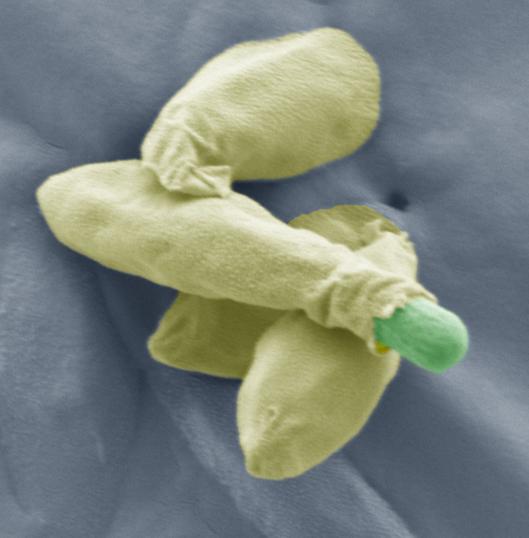Spores for thought

This is a false-colored electron microscopy image of a Clostridium sporogenes spore germinating. Credit: Kathryn Cross, Institute of Food Research
Researchers at the Institute of Food Research have established how clostridia bacteria emerge from spores. This could help them understand how these bacteria germinate and go on to produce the deadly toxin responsible for botulism, a lethal form of food poisoning, or cause food spoilage.
Clostridium botulinum bacteria produce the deadliest toxin known. Even tiny amounts of this toxin in food lead to botulism, which is fatal in 10% of cases. Clostridia bacteria survive in the environment as resilient, heat-resistant spores, so stringent safety measures are put in place in food processing. These ensure that botulism outbreaks are very rare, but to maintain food safety we need to understand as much as possible about how these bacteria survive and grow.
Scientists at the Institute of Food Research, which is strategically funded by the Biotechnology and Biological Sciences Research Council, have world-leading expertise in these bacteria, and have recently uncovered the genetic controls of spore germination in these bacteria. Now, in new research published in the journal Food Microbiology, they have visualised the structural changes spores undergo during germination.
Dr Jason Brunt worked with microscopist Kathryn Cross to produce images of the stages spores go through during germination. They examined Clostridium sporogenes, a close relative of Clostridium botulinum that although less dangerous, can cause significant food spoilage problems.
Their images showed that the spores have an outer covering, called an exosporium, with an aperture at one end. Closer examination showed that this aperture aligned with a spot on the spore where it ruptures during germination, and that the newly formed cell emerges through these holes. This suggests that the spores have polarity that aligns the structures correctly.
“We think that this polarity is genetically pre-determined in the dormant spore,” said Dr Jason Brunt. “Our long term aim is to formulate detailed strategies to interrupt these processes. This would be of great benefit to the food industry to help control these pathogenic and spoilage clostridia.”
###
Reference: Apertures in the Clostridium sporogenes spore coat and exosporium align to facilitate emergence of the vegetative cell, Jason Brunt et al, Food Microbiology doi:10.1016/j.fm.2015.04.013
Media Contact
All latest news from the category: Life Sciences and Chemistry
Articles and reports from the Life Sciences and chemistry area deal with applied and basic research into modern biology, chemistry and human medicine.
Valuable information can be found on a range of life sciences fields including bacteriology, biochemistry, bionics, bioinformatics, biophysics, biotechnology, genetics, geobotany, human biology, marine biology, microbiology, molecular biology, cellular biology, zoology, bioinorganic chemistry, microchemistry and environmental chemistry.
Newest articles

Trotting robots reveal emergence of animal gait transitions
A four-legged robot trained with machine learning by EPFL researchers has learned to avoid falls by spontaneously switching between walking, trotting, and pronking – a milestone for roboticists as well…

Innovation promises to prevent power pole-top fires
Engineers in Australia have found a new way to make power-pole insulators resistant to fire and electrical sparking, promising to prevent dangerous pole-top fires and reduce blackouts. Pole-top fires pose…

Possible alternative to antibiotics produced by bacteria
Antibacterial substance from staphylococci discovered with new mechanism of action against natural competitors. Many bacteria produce substances to gain an advantage over competitors in their highly competitive natural environment. Researchers…





















